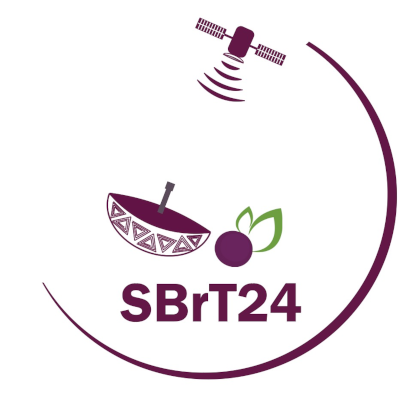
XLII Simpósio Brasileiro de Telecomunicações e Processamento de Sinais
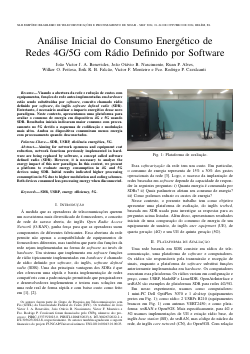
Análise Inicial do Consumo Energético de Redes 4G/5G com Rádio Definido por Software
João Victor Jorge Almeida Benevides, João Otávio Brasil Nascimento, Ruan P Alves, Wilker de O Feitosa, Erik Ray B. Falcão, Victor Farias Monteiro, Francisco R. P. Cavalcanti
DOI: 10.14209/sbrt.2024.1571036793
Keywords: SDR USRP eficiência energética 5G
Abstract
Visando a abertura da rede e redução de custos com equipamentos, funções de rede antes implementadas em hardware estão sendo substituídas por software, conceito chamado rádio definido por software, do inglês software defined radio (SDR). Entretanto, é necessário analisar o impacto energético desse novo paradigma. Neste contexto, apresentamos uma plataforma para avaliar o consumo de energia em dispositivos 4G e 5G usando SDR. Resultados iniciais indicaram maior consumo com processamento no 5G devido a esquemas de codificação e modulação mais altos. Ambos os dispositivos consumiram menos energia com processamento quando desconectados.Download
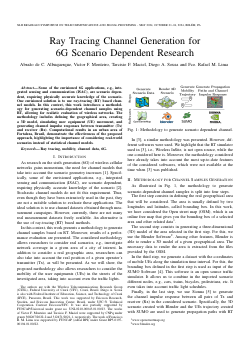
Ray Tracing Channel Generation for 6G Scenario Dependent Research
Abraão de Carvalho Albuquerque, Victor Farias Monteiro, Tarcisio Ferreira-Maciel, Diego Aguiar Sousa, Francisco Rafael Marques Lima
DOI: 10.14209/sbrt.2024.1571036796
Keywords: Ray tracing mobility channel data 6G
Abstract
Some of the envisioned 6G applications, e.g., integrated sensing and communication (ISAC), are scenario dependent, requiring physically accurate knowledge of the scenario. One envisioned solution is to use ray-tracing (RT) based channel models. In this context, this work introduces a methodology for generating scenario-dependent channel samples using RT, allowing for realistic evaluation of wireless networks. The methodology includes defining the geographical area, creating a 3D model, simulating user equipment (UE) movement, and generating channel impulse responses between transmitter (Tx) and receiver (Rx). Computational results in an urban area of Fortaleza, Brazil, demonstrate the effectiveness of the proposed approach, highlighting the importance of considering real-world scenarios instead of statistical channel models.Download
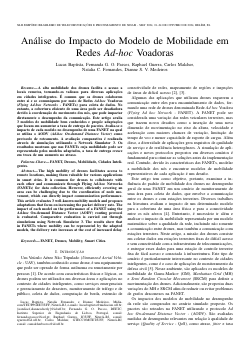
Análise do Impacto do Modelo de Mobilidade em Redes Ad-hoc Voadoras
Lucas Baptista de Moraes, Fernanda G. O. Passos, Raphael Guerra, Carlos Alberto Malcher Bastos, Natalia Fernandes, Dianne Medeiros
DOI: 10.14209/sbrt.2024.1571036797
Keywords: FANET Drones Mobility Smart Cities
Abstract
A alta mobilidade dos drones facilita o acesso a locais remotos, tornando-os valiosos para diversas aplicações em cidades inteligentes. É comum que os drones colaborem entre si e se comuniquem por meio de Redes Ad-hoc Voadoras (Flying Ad-hoc Networks - FANETs) para coleta de dados. No entanto, a cobertura eficiente de uma área pode ser desafiadora devido à coordenação do movimento dos nós, que pode impactar diretamente o desempenho da comunicação. Este artigo avalia 3 modelos de mobilidade bem conhecidos e propõe adaptações que focam em aumentar a taxa de entrega de pacotes. Avalia-se o impacto de cada modelo no desempenho de uma FANET na qual se utiliza o AODV (Ad-hoc On-demand Distance Vector) como protocolo de roteamento. A avaliação comparativa é realizada através de simulações utilizando o Network Simulator 3. Os resultados mostram que nas FANETs cuja mobilidade pode ser representada pelos modelos adaptados, a taxa de entrega cresce, em troca de um aumento no atraso.Download

Geração Caótica de Chaves para QKD
Renata Silva Queiroz, Yosdan Martínez Camejo Sr., Glendo de Freitas Guimarães, Joacir Soares Andrade, Daniel Gouveia
DOI: 10.14209/sbrt.2024.1571036800
Keywords: QKD NIST tests randomness cryptography
Abstract
In this work an empirical computational proposal is presented for the generation of encryption keys that can be used in quantum key distribution (QKD). The proposed method combines pseudorandom number generators, chaotic map and NIST 800-22 test for randomness certification. The rate of generation of random sequences obtained in the proposed system is no different from existing ones, such as those obtained from real random number generators or pseudorandom ones, but two added layers of security make spying difficult in QKD systems that use single photon detectors as APDs.Download
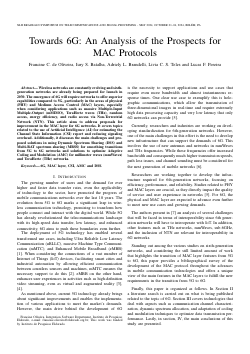
Towards 6G: An Analysis of the Prospects for MAC Protocols
Francine Oliveira, Iury Da Silva Batalha, Lívia Christinie Teles, Lucas Pereira, Adriely Lúcia Brandelli
DOI: 10.14209/sbrt.2024.1571036801
Keywords: 6G MAC layer CSI AMC
Abstract
Wireless networks are constantly evolving and sixth-generation networks are already being prepared for launch in 2030. The emergence of 6G will require networks to offer superior capabilities compared to 5G, particularly in the areas of physical (PHY) and Medium Access Control (MAC) layers, especially when considering applications such as massive MIMO (mMIMO), TeraHertz waves (THz), random access, energy efficiency, and radio access via non-terrestrial Network (NTN). This article aims to address proposals for improvement in the MAC layer for 6G networks. It covers topics related to the use of Machine Learning (ML) and Deep Learning (DL) for estimating the Channel State Information (CSI) report and reducing signaling overhead. Additionally, it discusses the main challenges and proposed solutions in using Dynamic Spectrum Sharing (DSS) and Multi-RAT spectrum sharing (MRSS) for smoothing transitions from 5G to 6G networks and solutions to optimize Adaptive Coding and Modulation (AMC) for millimeter waves (mmWaves) and THz networks.Download

Adaptação do Protocolo RPL para Aplicações com Mobilidade
João P Bittencourt, Carlos Marcelo Pedroso
DOI: 10.14209/sbrt.2024.1571036802
Keywords: Internet das Coisas Mobilidade Roteamento
Abstract
Este trabalho visa adaptar o protocolo RPL para cenários de mobilidade através da proposta de métrica de roteamento e função objetivo novas, com as quais se objetivou prever o movimento dos nós de modo a estabelecer rotas mais estáveis. O desempenho da proposta foi comparado com o do protocolo original via simulações computacionais, baseadas em traces reais do movimento de veículos em um ambiente urbano. A partir disto, observou-se uma melhora da taxa de entrega de pacotes, atraso e jitter fim-a-fim médios, assim como uma redução da quantidade média de trocas de pai na árvore de roteamento.Download
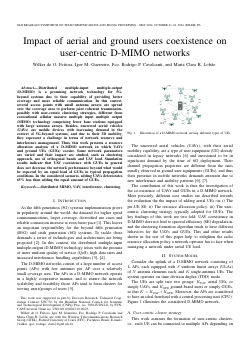
Impact of aerial and ground users coexistence on user-centric D-MIMO networks
Wilker de O Feitosa, Igor M. Guerreiro, Francisco R. P. Cavalcanti, Maria Clara R. Lobão
DOI: 10.14209/sbrt.2024.1571036804
Keywords: distributed MIMO UAV interference clustering
Abstract
Distributed multiple-input multiple-output (D-MIMO) is a promising network technology for 5G-beyond systems due to their capability of providing better coverage and more reliable communication. In this context, several access points with small antenna arrays are spread over the coverage area to perform joint coherent transmission, possibly with user-centric clustering strategies, different from conventional cellular massive multiple input multiple output (MIMO) technology comprising fewer base stations equipped with large antenna arrays. Besides, uncrewed aerial vehicles (UAVs) are mobile devices with increasing demand in the context of 5G-beyond systems, and due to their 3D mobility, they represent a challenge in terms of network resource and interference management. Thus, this work presents a resource allocation analysis of a D-MIMO network in which UAVs and ground UEs (GUEs) coexist. Some network parameters are varied and their impact are studied, such as clustering approach, use of orthogonal bands and UAV load. Simulation results indicate that UAV coexistence with GUEs in general does not decrease the network performance beyond what would be expected by an equal load of GUEs in typical propagation conditions.Download

A Heuristic for Mixed Integer and Nonlinear Programming in a WPCN-NOMA Scenario with Imperfect SIC
Pedro Victor Martins Castro, Francisco Rafael Marques Lima
DOI: 10.14209/sbrt.2024.1571036808
Keywords: wireless powered communication network (WPCN) non-orthogonal multiple access (NOMA) imperfect successive interference cancellation (SIC) wireless power transfer (WPT)
Abstract
This paper presents a wireless powered communication network (WPCN) that features a power beacon (PB) with multiple antennas for power transfer to terminals employing energy harvesting (EH). These terminals, each with a single antenna, in turn, use non-orthogonal multiple access (NOMA) to transmit their data to an access point (AP) with a single antenna, which employs imperfect successive interference cancellation (SIC). The objective of this work is to propose a heuristic that maximizes the throughput of the terminals subject to quality-of-service (QoS) conditions. To this end, comparisons of the heuristic with branch-and-bound (BB) through simulations are carried out, and it is demonstrated that the heuristic, by optimizing the power for each terminal, yields better results in terms of throughput and energy efficiency compared to the BB algorithm.Download
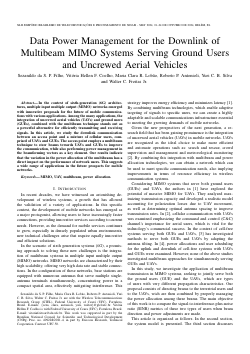
Data Power Management for the Downlink of Multibeam MIMO Systems Serving Ground Users and Uncrewed Aerial Vehicles
Sezanildo da Silva Paula Filho, Vitória Hellen Feitosa Coelho, Maria Clara R. Lobão, Roberto P. Antonioli, Yuri C. B. Silva, Walter da Cruz Freitas Jr.
DOI: 10.14209/sbrt.2024.1571036809
Keywords: MIMO UAV multibeam power alocation
Abstract
In the context of sixth-generation (6G) architectures, multiple input multiple output (MIMO) networks emerged with innovative proposals for the future of mobile communications with various applications. Among the many applications, the integration of uncrewed aerial vehicles (UAVs) and ground users (GUEs), combined with the multibeam technique stands out as a powerful alternative for efficiently transmitting and receiving signals. In this article, we study the downlink communication between an access point and a mixture of cellular users, comprised of UAVs and GUEs. The access point employs a multibeam technique to steer beams towards UAVs and GUEs to improve the communication, while also performing power management in the beamforming vectors as a key element. Our results indicate that the variation in the power allocation of the multibeams has a direct impact on the performance of network users. This suggests a wide range of applications in the future prospects for mobile networksDownload

Pre-Trained Language Models in Semantic Communication
Luiz Fernando Gontijo, Paulo Cardieri
DOI: 10.14209/sbrt.2024.1571036810
Keywords: Semantic Communications Language Models Signal Processing Deep Leaning
Abstract
Communication systems traditionally focus on accurately transmitting signals without considering semantic content. This paper introduces semantic communication models using pre-trained language models, T5 and BART, compared to conventional methods like Huffman and Turbo coding. Numerical results demonstrate the semantic models' superiority, especially in low SNR conditions, measured by BLEU and BERTScore metrics. Also, the proposed system only needs fine tuning to obtain good results in environments with severe fading. The results suggests a paradigm shift where decoding semantic meaning, rather than exact message replication, becomes crucial. Such models pave the way for novel communication architectures and emphasize the importance of semantic understanding in communication systems.Download